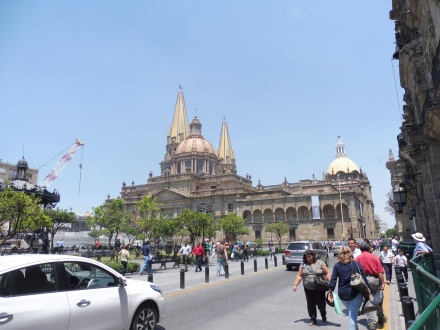
We took the “Directo” bus into Guadalajara the other day, with the intention of seeing the interior of the famed Teatro Degollado (it wasn’t open when we were last there), and then taking the local bus over to the artisan suburb of Tonalá, where so much of Jalisco’s crafts are made. We took a taxi to the Centro Historico, right next to the Teatro.
We were able to walk right in to the Teatro, and the attendants were eager to have us enjoy the beautiful interior. They even turned the lights on especially for us. The ceiling depicts scenes from The Divine Comedy. It was built between 1856 and 1866–the height of Mexico’s most European-inspired phase and at a time of its greatest theatrical production. As Spanish-speaking friends tell me, the word “degollado” means “beheaded”, a rather distressing name for a cultural center, but perhaps an appropriate title for a military general, which is who the theater is honoring: Santos Degollado (1811-1861), who had fought alongside Juarez and who died while the theater was being built. Guadalajara’s Philharmonic performs here, as does the opera. I would be most happy to attend a performance in this space.
After this visit, we went back to the elegant Hotel Morales, where we had eaten before. Such an inviting and comfortable space, where we had a lovely meal at a very reasonable price. Accommodation in this historic hotel is also amazingly affordable.
As we sat there reading fascinating books from the hotel’s little library, I decided that instead of going to Tonalá, which is all about selling things that we really weren’t going to buy, I needed a museum fix. So we looked at the Guadalajara tourist map, which led us to two museums right near the center of town. One of them–a museum of periodicals and graphics–is unfortunately closed for renovations, but the other one was such a gem that we were more than satisfied with our find.
The Museo de las Artes Populares de Jalisco (Calle San Felipe & Calle Pino Suárez) is housed in a delicately-stuccoed 19th-century villa about 4 blocks from the main plaza. “Popular arts” in this case means not only folk art, but also popular contemporary craft works. This was the museum that we thought we were going to see in Tlaquepaque, with the whole gamut of Jalisco’s traditional crafts on display. The exhibits are delightful, with the best explanatory labels I have seen in a museum anywhere, in Spanish and English. Finally, we were able to place technique with product and location; the labels even highlighted the best artisans of each technique. Now I can go back and link up all those ceramic pieces from the Panteleon with the correct style.
The objects on display included work in wax, stone, yarn, and obscure techniques such as chilte, objects made out of the sap of the sapodilla tree. And look at this excellent descriptive label:
My favorite displays were of altars and rooms. The replica of a traditional Jalisco kitchen was particularly charming. The altars were for a ritual for Our Lady of Sorrows, and a particular version of a Dia de los Muertos shrine, including bread figures, but not adding fruits or drink.
The Huichol people created a significant indigenous culture in Jalisco, and the museum has tremendous examples of their crafts and most revered images. The deer, which was most sacred to the Huichol, has been placed on the museum’s stairway wall, and yarn masks and beadwork occupy several rooms.
The reigning shrine of Guadalajara is dedicated to the Virgen de Zapopan, whose statue is the focus of a romeria, or pilgrimage procession, which takes place between June 13 and October 12 each year, when the figure travels to every church in Guadalajara. The museum naturally had a figure of this Virgin, festooned with sombrero and rebozo.
After such a rewarding afternoon of viewing objects of such tremendous skill and diversity, we decided that we would forego any other museum visits that day, and headed back to Ajijic. To our amazement, we found that this little jewel of a museum is not even mentioned in our Lonely Planet guide! I have a feeling that Guadalajara has so much more to offer than we have been able to see, and we have been disappointed that our guidebooks, what few we have found, have been so lackluster in their descriptions of the history and culture of the region. We’ll have to visit more often, and with natives who can show us the real city.
On that note, I will end with more images from the Museo, including, of course, a cat, this one of polished clay.































